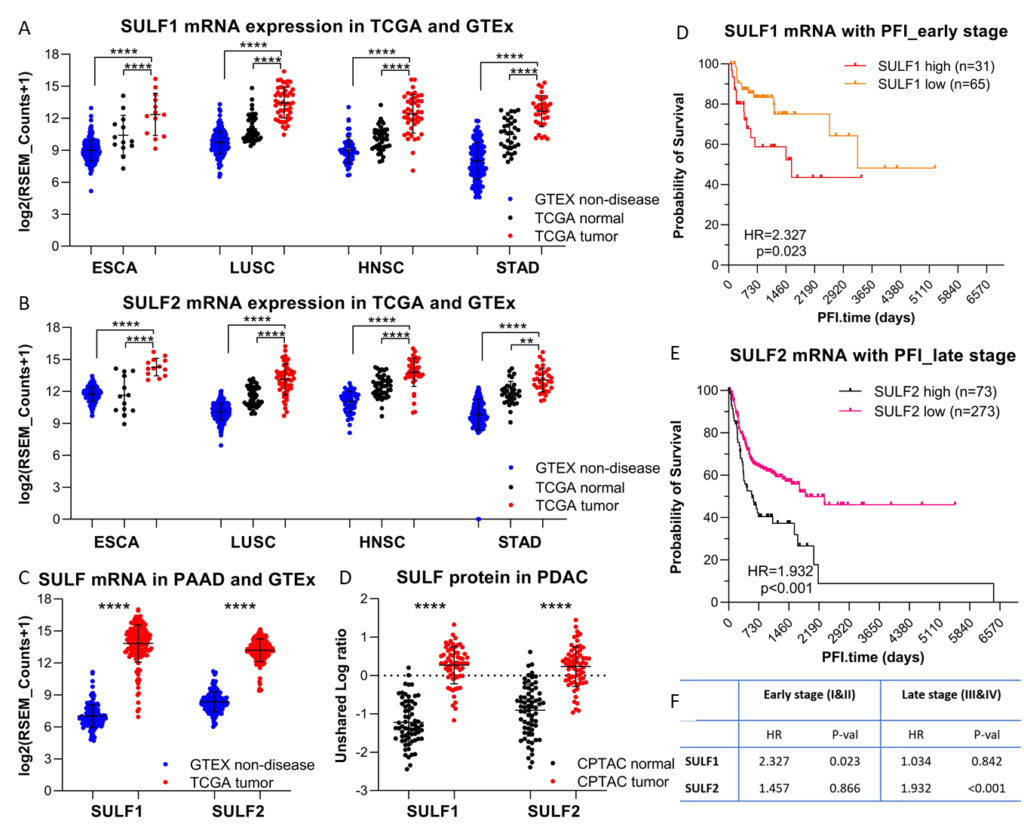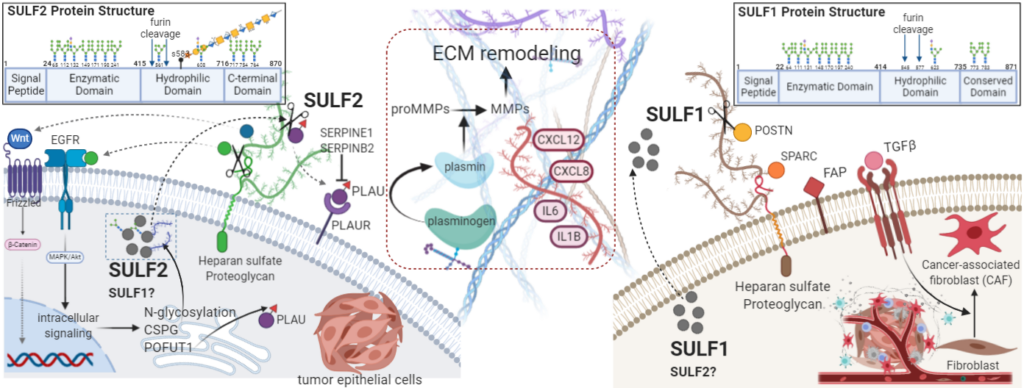Heparan Sulfation in HNSC and Other Malignancies
Posted in Projects
Heparan 6-O-endosulfatases, SULF1 and SULF2, are significantly elevated in head and neck squamous cell carcinoma (HNSC) tissues at all stages of the disease progression and are associated with poor prognosis [1]. SULF1 and SULF2 are oncogenic in a number of human malignancies, including HNSC, and functions of the 65% identical enzymes were considered largely redundant. However, our recent results suggest that their functions in cancer biology are distinct, in line with recent information on their distinct post-translational modifications [2]. In tumor tissues, cancer cells are the main supplier of SULF2 but SULF1 is supplied by cancer-associated fibroblasts (CAF), a cell type associated with invasiveness of tumors and escape from immune surveillance. It explains how the SULF1, marginally expressed in tumor cell lines, increases with high consistency in HNSCC and many other cancers and suggests why we observe a highly significant impact of SULF1 on survival an early stage of HNSC. To strengthen the evidence for a functional impact of the SULF enzymes, we study enzymology of the human enzymes and their biology in cell and animal models of HNSC.

Figure 1. Expression of SULF1 and SULF2 in five cancer types. (A) SULF1 and (B) SULF2 mRNA in tumor compared to paired normal tissue of cancer patients in TCGA datasets and to non-disease tissues of healthy donors from GTEx; (C) SULF1 and SULF2 mRNA in the PAAD tumor compared to pancreatic tissue from GTEX. (D) SULF1 and SULF2 protein in the PDAC tumor and adjacent non-cancer tissues from CPTAC; p<0.001(****), p<0.01(**). Impact of SULF1 and SULF2 expression on PFI of HNSC patients differs between early and late stage tumors. (D) SULF1 is associated with PFI in early stage HNSC; (E) SULF2 is associated with PFI in late stage HNSC. (F) Summary statistics of the PFI in the early and late stage tumors.

Figure 2. RNAScope of OSCC tumors: A. a tongue cancer stained for DAPI (blue), cytokeratin (green), and with in situ probes for SULF1 (red) and SULF2 (yellow). SULF1 localizes to the stroma, SULF2 is expressed mainly in the tumor epithelial cells. Adjacent normal tissue is mostly negative for both SULF1 and SULF2. B. percent of cells expressing SULF1 or SULF2 differ between the tumor epithelial and fibroblast cells (p<0.001) based on a single cell RNA-seq study of 5,578 cells from tumor tissues of 18 HNSCC patients (Puram S.V. et al., 2017).

- Expression of the Extracellular Sulfatase SULF2 Affects Survival of Head and Neck Squamous Cell Carcinoma Patients. Yang Y, Ahn J, Raghunathan R, Kallakury BV, Davidson B, Kennedy ZB, Zaia J, Goldman R. Front Oncol. 2021.
- Extracellular endosulfatase Sulf-2 harbors a chondroitin/dermatan sulfate chain that modulates its enzyme activity. El Masri R, Seffouh A, Roelants C, Seffouh I, Gout E, Pérard J, Dalonneau F, Nishitsuji K, Noborn F, Nikpour M, Larson G, Crétinon Y, Friedel-Arboleas M, Uchimura K, Daniel R, Lortat-Jacob H, Filhol O, Vivès RR. Cell Rep. 2022.
